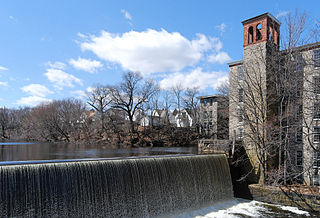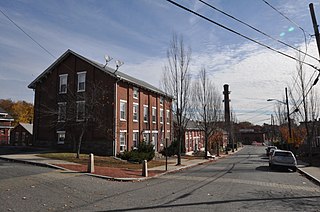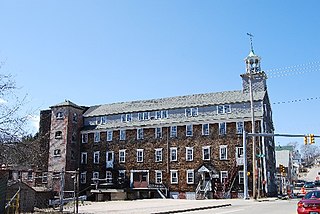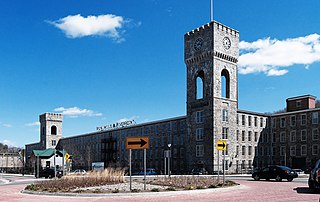
Lippitt, Rhode Island is a village [1] within the town of West Warwick, Rhode Island.

Lippitt, Rhode Island is a village [1] within the town of West Warwick, Rhode Island.
Lippitt was founded by Revolutionary War General Christopher Lippitt and his brother Charles Lippitt when they and their partners constructed Lippitt Mill in 1809 and the surrounding mill village for their workers. [2] During the Depression following of War of 1812, the Lippitt Manufacturing Company survived by supplying yarn to convict weavers in the Vermont prison. The original mill and several of the workers row houses still survive. It is one of the oldest cotton mills in New England and has been sold to several owners since the Lippitt family sold it 1889. [3]
The Mill is on the National Register of Historic Places, [4] and is one of the earliest textile mills in Rhode Island. It is one of the oldest American textile mills still used for manufacturing. [5]

West Warwick is a town in Kent County, Rhode Island, United States. The population was 31,012 at the 2020 census.

River Point in West Warwick, Rhode Island, United States, is a community made up of mill houses and three mills - the Valley Queen Mill, the Royal Mill and the Cotton Shed. Built in 1834 by the Greene Company, the Valley Queen Mill is the oldest of the three buildings. It originally operated as a cotton factory, producing coarse cotton cloths under the Greene Company name.

The North Branch Pawtuxet River is a river in the U.S. state of Rhode Island. It flows approximately 8.9 miles (14.3 km). There are 9 dams along the river's length.

The South Branch Pawtuxet River is a river in the U.S. state of Rhode Island. It flows approximately 9.8 miles (15.8 km). There are 11 dams along the river's length.

Lonsdale is a village and historic district in Lincoln and Cumberland, Providence County, Rhode Island, United States, near Rhode Island Route 146 and Route 95. The village was originally part of the town of Smithfield until Lincoln was created in the 1870s, and was originally centered on the Lincoln side of the Blackstone River. William Blaxton settled in the area in 1635. In the nineteenth and early twentieth centuries, Lonsdale was home to several manufacturers including the Lonsdale Company's Bleachery, and the Ann & Hope mill was also located in the village in Cumberland.

Saylesville is a village and historic district in Lincoln, Rhode Island.

The Hanora Mills are a historic textile mill complex the center of Woonsocket, Rhode Island.

Hillsdale Historic and Archeological District is a historic district in Richmond, Rhode Island. The district was added to the National Register of Historic Places in 1980. It represents the site of the former textile mill village of Hillsdale.

The Hope Village Historic District is a historic rural mill settlement within Hope Village in Scituate, Rhode Island. Hope Village is located on a bend in the North Pawtuxet River in the southeastern corner of Scituate. Industrial activity has occurred in Hope Village since the mid-eighteenth century. Surviving industrial and residential buildings in the Historic District date back to the early 19th century. The village center sits at junction of Main Street and North Road. Hope Village radiates out from the center with houses on several smaller side streets in a compact configuration. Currently there is little commercial or industrial activity in Hope Village and none in the Historic District. The present stone mill building on the south side of Hope Village was built in 1844 by Brown & Ives of Providence, expanded in 1871 and modified in 1910. Approximately one quarter of the village's current housing stock was built as mill worker housing by various owners of Hope Mill.

The Centreville Mill is an historic textile mill at 3 Bridal Avenue in West Warwick, Rhode Island. The mill complex is located on a site that has been used for textile processing since 1794, only four years after Samuel Slater's successful mill operation was established in Pawtucket. The oldest surviving buildings on the east side of the Pawtuxet River date to the 1860s.

The Crompton Free Library is a historic library building in West Warwick, Rhode Island. The small single-story wood-frame building was constructed in 1876, with funding from local mill owners. It is an excellent local example of a small Stick style public structure.

The Crompton Mill Historic District is a historic district encompassing a mill complex at 20 Remington Street, 53 and 65 Manchester Street in West Warwick, Rhode Island. The mill complex consists of a collection of mainly brick buildings, bounded by the Pawtuxet River and Pulaski, Remington, and Manchester Streets in the village of Crompton. The mill complex formerly extended across the river, but the complex on the west bank was destroyed by fire in 1992. The oldest elements of the complex are the dam site and some of the raceways that provided water power to the mills. The present dam was built in 1908, replacing an 1882 structure. The raceways were built in 1807, around the time of the first mill buildings. The stone Mill No. 1, built 1807, is believed to be the oldest stone mill building in the state. Most of the complex's buildings were built in the late 19th and early 20th centuries by the Providence Manufacturing Company and its successors. The mill was used for textile processing until 1946, when the Crompton Corporation ended production.

The Lippitt Mill is a historic mill at 825 Main Street in West Warwick, Rhode Island.

The Pawtuxet Valley Dyeing Company was a historic mill complex at 9 Howard Avenue in the town of Coventry, Rhode Island. The complex included three buildings: the main mill building and two pump houses, as well as the dam which impounds the Pearce Mill Pond, and the tailrace which evacuates water from the mill into the North Branch Pawtuxet River.

The Royal Mill Complex is an historic textile mill site at 125 Providence Street in West Warwick, Rhode Island. The mill complex was listed on the National Register of Historic Places in 2004. It has recently been completely renovated and remodeled into 250 residential apartments. The complex also includes the Ace Dye Works mill on the south side of the river, which has been converted into lofts. A pedestrian skybridge connects the two mills.

The Valley Queen Mill is an historic mill at 200 Providence Street in West Warwick, Rhode Island.

The Church Hill Industrial District is an industrial historic district on the west side of Pawtucket, Rhode Island. It encompasses an area that was intensively developed between about 1850 and 1920, and includes five separate industrial facilities. Four of these are relatively modest in size, and originally served a combination of textile mills and ironworks, the latter of which often manufactured parts used in the textile manufacturing processes. The oldest building is an 1848 ironworks facility, which runs along Pine Street between Main and Bayley. The largest single complex, added in the 2011 expansion of the district, is the Union Waddell complex between Bayley Street and the Amtrak railroad tracks, which has ten surviving buildings from the early 20th century.

Anthony is a village along Route 117 within the town of Coventry, Rhode Island near the villages of Washington and Quidnick on the southwestern banks of the Pawtuxet River. The village comprises "Anthony, Arnold, Boston, Mapledale, Meeting, Taft, Washington and Laurel Avenue."

Harris is a village near the town of Coventry, Rhode Island on the north branch of the Pawtuxet River near West Warwick.

Blackstone River Valley National Historical Park is a National Park Service unit in the states of Rhode Island and Massachusetts. The park was created for the purpose of preserving, protecting, and interpreting the industrial heritage of the Blackstone River Valley and the urban, rural, and agricultural landscape of that region. The Blackstone River Valley was the site of some of the earliest successful textile mills in the United States, and these mills contributed significantly to the earliest American Industrial Revolution. The subsequent construction of the Blackstone Canal, a few years after the successful completion of the Erie Canal, helped to sustain the region's industrial strength.